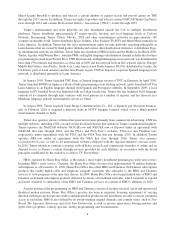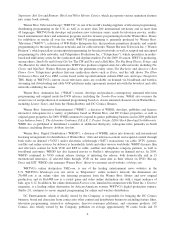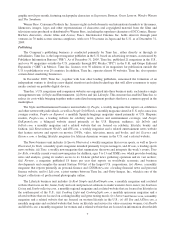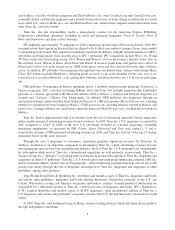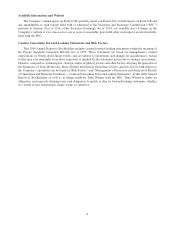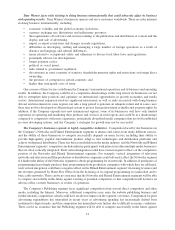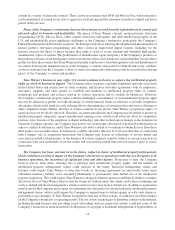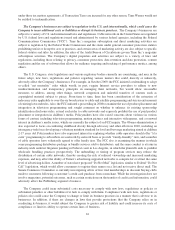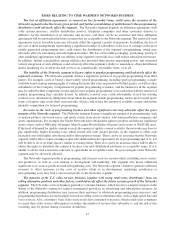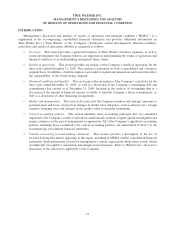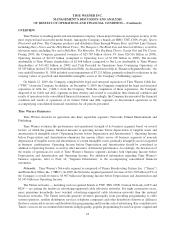Time Magazine 2009 Annual Report Download - page 24
Download and view the complete annual report
Please find page 24 of the 2009 Time Magazine annual report below. You can navigate through the pages in the report by either clicking on the pages listed below, or by using the keyword search tool below to find specific information within the annual report.Time Warner faces risks relating to doing business internationally that could adversely affect its business
and operating results. Time Warner’s businesses operate and serve customers worldwide. There are risks inherent
in doing business internationally, including:
• economic volatility and the global economic slowdown;
• currency exchange rate fluctuations and inflationary pressures;
• the requirements of local laws and customs relating to the publication and distribution of content and the
display and sale of advertising;
• import or export restrictions and changes in trade regulations;
• difficulties in developing, staffing and managing a large number of foreign operations as a result of
distance and language and cultural differences;
• issues related to occupational safety and adherence to diverse local labor laws and regulations;
• potentially adverse tax developments;
• longer payment cycles;
• political or social unrest;
• risks related to government regulation;
• the existence in some countries of statutory shareholder minority rights and restrictions on foreign direct
ownership;
• the presence of corruption in certain countries; and
• higher than anticipated costs of entry.
One or more of these factors could harm the Company’s international operations and its business and operating
results. In addition, the Company could be at a competitive disadvantage in the long term if its businesses are not
able to strengthen their positions and capitalize on international opportunities in growth economies and media
sectors. International expansion involves significant investments as well as risks associated with doing business
abroad, and investments in some regions can take a long period to generate an adequate return and in some cases
there may not be a developed or efficient legal system to protect foreign investment or intellectual property rights. In
addition, if the Company expands into new international regions, some of its businesses will have only limited
experience in operating and marketing their products and services in such regions and could be at a disadvantage
compared to competitors with more experience, particularly diversified media companies that are well established
in some developing nations, and the Company’s strategies for growth may not be successful.
The Company’s businesses operate in highly competitive industries. Competition faced by the businesses in
the Company’s Networks and Filmed Entertainment segments is intense and comes from many different sources,
and the ability of these businesses to compete successfully depends on many factors, including their ability to
provide high-quality, popular entertainment product, adapt to new technologies and distribution platforms and
achieve widespread distribution. There has been consolidation in the media industry, and the Networks and Filmed
Entertainment segments’ competitors include industry participants with interests in other multiple media businesses
that are often vertically integrated. Such vertical integration could have various negative effects on the competitive
position of the Networks and Filmed Entertainment segments. For example, vertical integration of television
networks and television and film production or distribution companies could adversely affect the Networks segment
if it hinders the ability of the Networks segment to obtain programming for its networks. In addition, if purchasers of
programming increasingly purchase their programming from production companies with which they are affiliated,
such vertical integration could have a negative effect on the Filmed Entertainment segment’s licensing revenues and
the revenues generated by Home Box Office from the licensing of its original programming in syndication and to
basic cable networks. There can be no assurance that the Networks and Filmed Entertainment segments will be able
to compete successfully in the future against existing or potential competitors or that competition will not have an
adverse effect on their businesses or results of operations.
The Company’s Publishing segment faces significant competition from several direct competitors and other
media, including the Internet. Moreover, additional competitors may enter the website publishing business and
further intensify competition, which could have an adverse impact on the segment’s revenues. Competition for print
advertising expenditures has intensified in recent years as advertising spending has increasingly shifted from
traditional to digital media, and this competition has intensified even further due to difficult economic conditions.
There can be no assurance that the Publishing segment will be able to compete successfully in the future against
12




